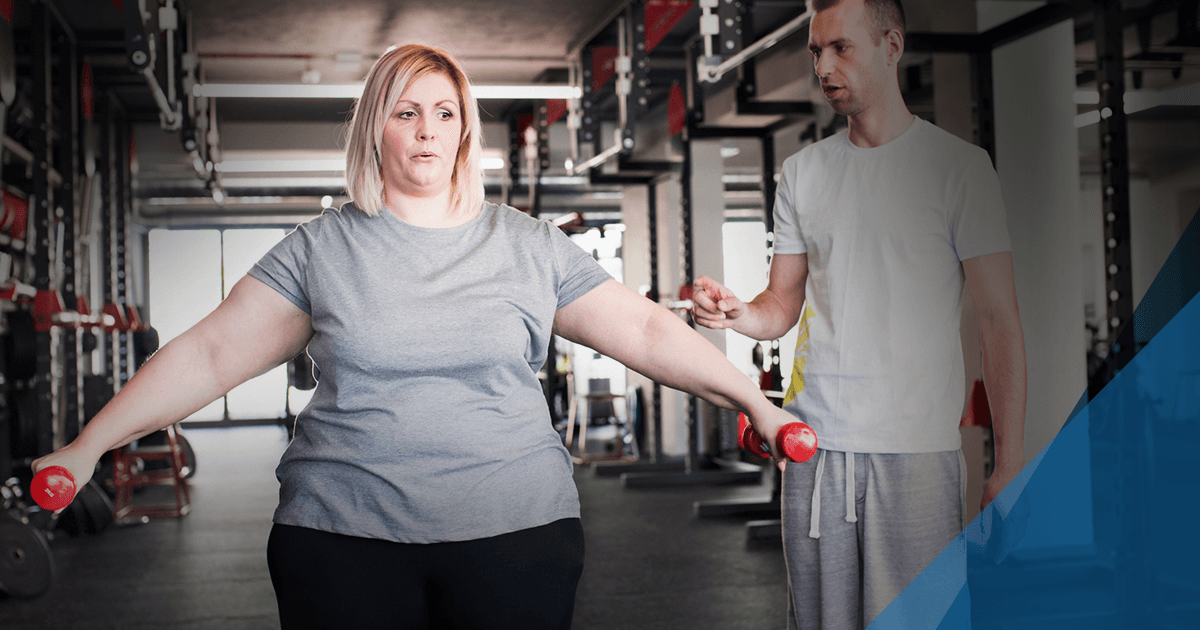Over 34.9% of Americans are currently obese.1
However, there's also a fitness revolution sweeping the country. And sooner or later, this revolution is going to drop off a morbidly obese client right at your doorstep.
This can be a pretty tricky situation the first couple of times because you'll quickly realize that a morbidly obese person can't do everything that your average client can. They know that they need to train if they ever expect to lose weight, and you do as well, but do you know what to do with them?
Here are a few things you have to keep in mind when training obese clients.
1. Their size may literally prevent them from being able to do certain exercises
Take the leg press, for example. It's going to be much more uncomfortable for them to perform the movement than it is for somebody of normal weight. The bulk of their stomach is going to prevent them from being able to squat deep enough. What about if you use other pieces of equipment such as a chest press? Will they be able to fit between the handles? You need to be aware of things like this.
2. If you use equipment, you need to be aware of the weight limit
If you use selectorized machines, do you know the weight limits on them? What about your treadmills? What about other pieces of equipment you may use, such as balance boards, Bosu balls, and the like?
If you repeatedly set somebody who is well over 400 pounds on a machine that only supports 350, eventually somebody is going to end up hurt. You're either going to strip the seat bolt, the equipment will break/pop, or the treadmill is going to have issues.
Don't put somebody on a treadmill that they are too heavy for. When the treadmill doesn't work, it's humiliating for them -- and embarrassing for you.
3. Some exercises create a little bit more "jiggle" than others
Mountain climbers, jumping jacks, burpees, bicycle sprints, and other exercises that require a lot of movement may be great for your normal sized individual, but for somebody who is morbidly obese, these exercises can cause a lot of embarrassing extra jiggle. They got to their current size in part because they viewed working out as something strange and embarrassing.
Part of your job is to make them more comfortable with working out, and if you don't, they will leave, and you will have lost an extra client and potential income.
If you still decide that you need to include this type of training with your clients, then do it in a place with a little bit more privacy. Just as a girl may not feel comfortable doing squats so that her butt is facing the guys in the weight room, somebody who's morbidly obese may not feel comfortable doing mountain climbers there in public.
4. Use discretion with workout intensity
This one's pretty obvious, but I think a lot of trainers overlook this. They spend their evenings watching The Biggest Loser, and then expect their clients to do the same. Unless you've got a doctor on site, have had them sign their life away to you, and have some pretty sweet insurance this is NOT a good idea.
You should be able to create a workout for somebody who is 362 pounds without them feeling as if they need to throw up or are going to pass out. And yes, it is possible to get results without the two.
5. It's hard for them to get off of the floor
You're probably going to end up running some type of circuit/interval style workout with an obese client. If you're going to do so, try not to create the program in a way that causes the client to have to get up and off of the floor repeatedly.
A lot of these people have joint issues, and getting up is going to be a pretty slow, laborious process for them. If I want to utilize a specific exercise with my client that necessitates the use of the floor, I make sure that I can include other exercises while they're down there.
For example, if I want them to do knee pushups, I'm also going to have them do dead bugs, side planks, glute bridges, and the like from down there. That way we can still run an awesome mini-circle within our circuit workout, but we can avoid wasting time and energy getting up and off the floor over and over.
6. Watch the impact
Excess weight on the body is excess weight on the joints. Research shows that for every excess pound carried, 4 extra pounds of stress are loaded onto the knee.2 Jumping causes the knees to be loaded 4-7x bodyweight.3 So when you picture what happens to the knees of a 350 pound male is jump roping, it's not a pretty picture.
A lot of your morbidly obese clients are going to have the beginnings of some sort of joint issue already, whether it's in the knees, back, or hips. Having them performing high-impact activities such as running, jump-roping, and the like is not what they need at the moment.
I typically don't start clients doing these types of exercises until they've lost a significant amount of weight. Until that point though, there's plenty of other low-impact ways to create an awesome training program for them.
7. Keep some form of simple carbohydrate available
Jon mentioned before in one of his posts that he always kept some form of sugar in his desk for the potential hypoglycemic diabetic. That's incredibly wise with this population.
Editors note: Here's the article that Zac's referring to: http://www.theptdc.com/2012/02/whats-in-my-desk/
For someone to become morbidly obese and NOT develop Type 2 diabetes is a small miracle in, and of, itself. If you work with people in this population, you need to be prepared to work with diabetics. And if you want to work with diabetics, you need to be prepared for possible low blood-sugar episodes.
Editors note: Here's an article on training the diabetic client.
You're going to be pushing them to work their hardest, and they are going to want to prove to both you, themselves, and the world that they can do this.
Unfortunately, with diabetes on the table, things can get a bit messy at times, and you need to be prepared.
Don't intentionally kill them with your workout, but do be prepared with some form of orange juice, candy, crackers, something to help them to get out of the funk.
8. Always encourage
It doesn't matter if you're a drill sergeant style trainer, or the cheerleader, you need to be sure that no matter what, you're always encouraging your clients.
They need to know that you believe in them. They've had too many people in their lives that have told them that they can't do this, that they're lazy slobs, and treated them like garbage. They did not come to you to hear what they can hear at home.
They came to you likely because they have this grand notion in their head of what a personal trainer is. You're the person that is going to never stop believing in them. You're the person who will always push them to do their best. You're the person that is going to help them to achieve what seems like a far-off dream.
That is why they came to you. And it is your job to not only do those things, but to do them with enthusiasm along the way.
In Conclusion
Training obese clients can be extremely rewarding. When you can coach somebody through a 150-pound weight loss journey, and you get to see the positive changes that have come about as a result in their lives, it fills you with life. However, you need to be conscious of a few things while you are cheering them on down this road. And if you can successfully remember these things, while simultaneously creating awesome workouts, you're going to have an extraordinary effect on the lives of your clients.
xxx
Further Reading:
Training the Diabetic Client - TJ Allen
What's in my Desk? - Jonathan Goodman
Is the Biggest Loser Ruining Personal Training? - Jonathan Goodman
Fixing Bad Pushups - Dean Somerset
References
- The Centers for Disease Control and Prevention. Adult obesity facts. http://www.cdc.gov/obesity/data/adult.html . Published September 9, 2014.
- The Arthritis Foundation. How fat affects arthritis. http://www.arthritistoday.org/about-arthritis/arthritis-and-your-health/obesity/fat-and-arthritis.php Published 2012.
- Nissel R, Mizrah J. Knee and ankle joint forces during steps and jumps down from two different heights. Clinical Biomechanics. 1988; 3(2):92-100.










